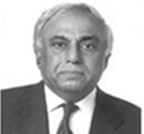 | Department of Economics |
| NEWS & MEDIA |
MEDIA
A Turning Point
|
ECONOMIC history is a fascinating subject, and at its exciting best when one tries to explain to graduate students why Britain was the first country to have undergone the Industrial Revolution, or why Japan was the first non-Western country to do so — or more recently, the unparalleled high growth rates achieved by the East Asian ‘tiger’ countries and their rapid transition to industrialised economies.
|
In contrast, given its impressive start as a galvanised new nation, Pakistan is taught as a country that was considered a leading candidate to achieve a similar breakthrough, well before the East Asian economies or even China and India and, indeed, many times after that — but unfortunately never fully realised its true economic potential.
Again, the reasons attributed are many, but three factors dominate besides the overarching low and extremely poor human development indicators. The first is the low levels of investment and savings — due in large measure to high levels of conspicuous consumption by the ruling elite while paying little tax despite high profits, and the transfer of significant earnings abroad. The second: an inefficient allocation of resources through a trade and foreign exchange regime that created a highly protected domestic market with a strong anti-export bias, while increasing reliance on foreign loans and accumulating unsustainable debt. The third was poor management of the economic reforms initiated over the last three decades, mostly under IMF tutelage.
A major flaw in the reform process lay in opening up the economy at a pace that far exceeded its foreign exchange earnings. This resulted in recurring stop-go cycles and unavoidable stabilisation measures, as we are currently experiencing. India carried out very similar reforms, but only selectively opened up the economy at an affordable pace, and never opened up its capital account despite considerable pressure, while Pakistan did so as early as 1992, triggering unhindered flows of foreign exchange abroad.
The present PTI government has also embarked — as its predecessors did — on turning the economy around, again under an IMF programme, but with some significant differences that make one far more hopeful of success. First and foremost, it has come down hard on those who have illegally gained and transferred their wealth abroad — a major reason for our past failures. The second: that it has at its helm an unimpeachably honest leader who enjoys the trust of the people on this account alone. The third: despite the hardship entailed, the government has taken unpopular decisions to bring the economy out of its current twin unsustainable fiscal and trade deficits through strong measures, including expanding the tax net, cutting down unafford¬able subsidies, and moving to a market-driven exchange rate. Finally, it is committed to eradicating poverty and providing basic needs, including education, health and housing under a well thought-out social protection programme.
But are these measures sufficient? Do they reflect the gravity of the threat the country faces after the illegal annexation of India-held Kashmir by a belligerent and increasingly fascist neighbour? What more needs to be done?
To rise to this formidable challenge, Pakistan now needs to do far more, especially on the economic front, as it faces what one might term its ‘Japanese moment of 1868’. This is because India is fully aware that, militarily, Pakistan is more than capable of defending itself as a nuclear power. India’s aggressive and chauvinistic posture rides mainly on the back of its economic performance over the last two decades, which Pakistan has unfortunately not been able to match, despite having outperformed India economically in the earlier years.
At this critical turning point, Pakistan must therefore undertake far-reaching, decisive economic policy measures and reforms beyond those envisaged under the current IMF programme, which emphasises necessary stabilisation, but not sufficiently on the revival of economic growth. More than ever, there is an urgent need to build a consensus between all the major players — private and public — and come up with clear-cut rules of the game. These rules will provide a harassment-free investment climate and, in turn, require a responsible private sector that pays its taxes and does not seek endless subsidies and continual protection. Suitable reforms must also be taken to reverse deindustrialisation and stop unfair competition, especially from smuggled raw materials and final goods. This will encourage entrepreneurs, domestic and foreign, to invest in Pakistan.
Clearly, the current government economic machinery is not geared to building such a consensus that embraces private investment and pools the inputs of those who actually take the input and output decisions. Serious consideration, therefore, needs to be given to having the recently set up National Development Council (NDC) play this role: it already includes as members, besides the finance and planning ministers, the foreign minister and the chief of army staff, as well as the chief ministers of the provinces, but it needs to be enlarged to include the private sector and other key economic players.
To operationalise its working, a restructured and technically strengthened Planning Commission (renamed the ‘Economic Reform and Change Commission’) could serve as the secretariat to the NDC. With the prime minister at its helm, this new body would have the muscle, strength and broad-based ownership to promote economic growth and undertake far-reaching structural changes. All economic reform plans emanating from this new body should be presented to and approved by the parliament.
If we are to ensure peace in South Asia and fully support the rights of the people of Kashmir against India’s naked aggression, we need to re-establish ourselves as a vibrant, competitive and technologically advanced economy, and be recognised as such by our neighbours and, indeed, by the rest of the world.
This article has been written by Dr. Rashid Amjad, Professor& Director, Graduate Institute of Development Studies, Lahore School of Economics and former vice chancellor of the Pakistan Institute of Development Economics
Link to the article in Dawn People
People